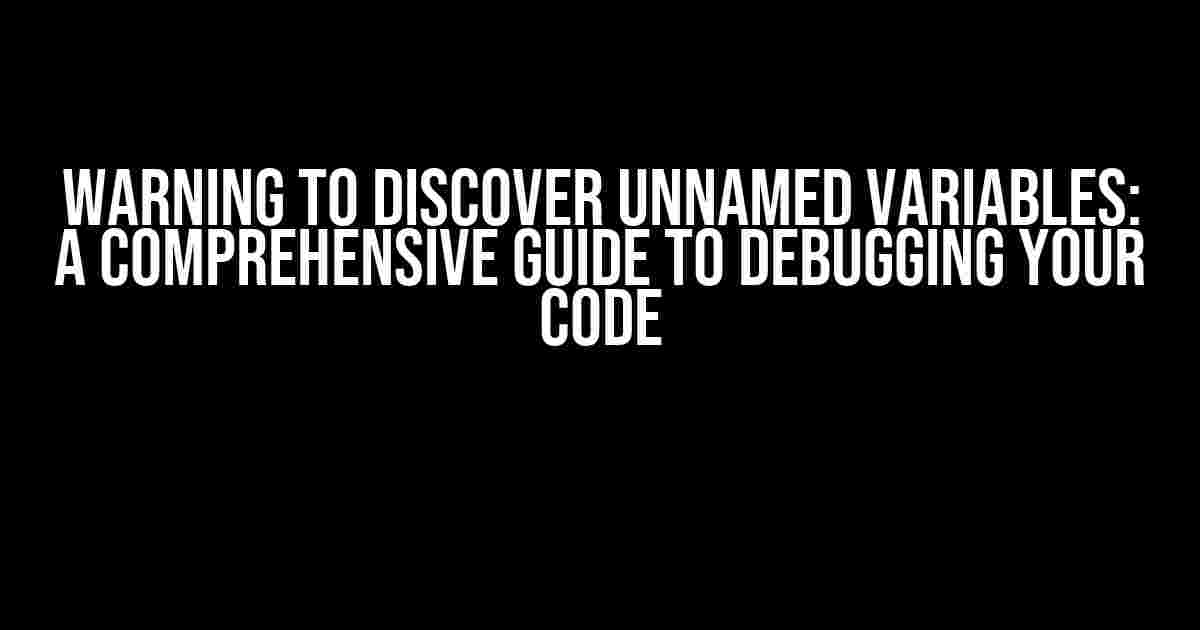As a developer, there’s nothing more frustrating than encountering an error message that reads “Warning: Unnamed variables detected.” It’s like having a puzzle with missing pieces – you’re left wondering what went wrong and how to fix it. In this article, we’ll delve into the world of unnamed variables, explore the common causes, and provide you with a step-by-step guide to discovering and resolving these pesky errors.
What are Unnamed Variables?
In programming, an unnamed variable is a variable that is declared without a name or identifier. This can occur due to typos, incorrect syntax, or even a simple oversight. Unnamed variables can lead to a range of issues, including runtime errors, data loss, and decreased code performance.
Common Causes of Unnamed Variables
Before we dive into the solution, let’s explore the common causes of unnamed variables:
- Typos: A single mistyped character can result in an unnamed variable.
- Incorrect Syntax: Using incorrect syntax or forgetting to include necessary keywords can lead to unnamed variables.
- Copy-Paste Errors: Copying and pasting code without properly editing it can result in unnamed variables.
- Lack of Code Review: Failing to review code thoroughly can lead to missed unnamed variables.
Discovering Unnamed Variables
To identify unnamed variables, you’ll need to employ a combination of coding skills and detective work. Here are some steps to help you get started:
Step 1: Enable Debug Mode
Most programming languages and IDEs offer a debug mode that allows you to identify errors and warnings. Enable debug mode to receive notifications about unnamed variables.
Step 2: Review Code Line-by-Line
Go through your code line-by-line, paying close attention to variable declarations. Look for any variables that are not assigned a name or identifier.
Step 3: Use Code Analysis Tools
Utilize code analysis tools, such as linters or code sniffers, to identify potential issues. These tools can help detect unnamed variables, syntax errors, and other problems.
Step 4: Check for Variable Shadowing
Variable shadowing occurs when a variable is declared with the same name as an existing variable. This can lead to unnamed variables. Check your code for any instances of variable shadowing.
Resolving Unnamed Variables
Once you’ve identified the unnamed variables, it’s time to resolve the issue. Here are some steps to follow:
Step 1: Assign a Name to the Variable
Assign a unique and descriptive name to the unnamed variable. This will help you and others understand the variable’s purpose.
Step 2: Update Code References
Update any code references that point to the unnamed variable. Make sure to update all instances of the variable to reflect its new name.
Step 3: Test Your Code
Thoroughly test your code to ensure the unnamed variable has been properly resolved. Run your code through a series of tests to verify its functionality.
Best Practices to Avoid Unnamed Variables
To avoid unnamed variables in the future, follow these best practices:
- Use Meaningful Variable Names: Choose descriptive and meaningful names for your variables to avoid confusion.
- Follow a Consistent Naming Convention: Establish a consistent naming convention throughout your code to make it easier to identify variables.
- Use Code Analysis Tools: Regularly use code analysis tools to identify potential issues and unnamed variables.
- Code Review: Perform regular code reviews to catch errors and unnamed variables early on.
Conclusion
Unnamed variables can be a frustrating and time-consuming issue to resolve, but with the right skills and tools, you can overcome this hurdle. By following the steps outlined in this article, you’ll be well on your way to discovering and resolving unnamed variables in your code. Remember to stay vigilant, follow best practices, and never underestimate the power of a well-named variable.
// Example of an unnamed variable
var = 10;
// Corrected code with named variable
var myVariable = 10;
| Unnamed Variable | Named Variable |
|---|---|
|
|
By following these guidelines and best practices, you’ll be able to identify and resolve unnamed variables, ensuring your code is efficient, readable, and error-free.
Remember, a warning to discover unnamed variables is not a warning to ignore – it’s a warning to take action and improve your code. So, take the necessary steps to identify and resolve unnamed variables, and watch your code thrive.
Now, go forth and conquer the world of coding – one named variable at a time!
Frequently Asked Question
Get the inside scoop on “Warning to discover unnamed variable” and avoid the pitfalls of coding ignorance!
What is the “Warning to discover unnamed variable” all about?
This warning is a gentle nudge from your coding buddy (aka the compiler) that you’ve got an unnamed variable lurking in your code. It’s like a little treasure that’s yet to be named, but it’s essential to give it a proper name to avoid confusion and errors down the line!
Why does the compiler throw this warning?
The compiler is being proactive because it wants to prevent potential issues in your code. Unnamed variables can lead to misunderstandings, and the compiler is trying to guide you towards writing more readable and maintainable code. It’s like a safety net to catch those sneaky bugs before they cause chaos!
How do I fix this warning?
Easy peasy! Just give that variable a proper name, and the warning will disappear like magic! Make sure the name is descriptive and follows the variable naming conventions in your programming language. Voilà, problem solved!
What happens if I ignore this warning?
Ignoring this warning can lead to a world of trouble! Unnamed variables can cause confusion, errors, and even crashes. It’s like building a house on shaky ground – it might look fine at first, but it’ll come crumbling down eventually. So, take the compiler’s advice and give those variables a name – your code (and your sanity) will thank you!
Can I suppress this warning?
While it’s technically possible to suppress the warning, it’s not recommended. Suppressing the warning won’t fix the underlying issue, and you might end up with a codebase that’s prone to errors and maintainability nightmares. Instead, take the compiler’s warning as an opportunity to improve your code and make it more robust!



